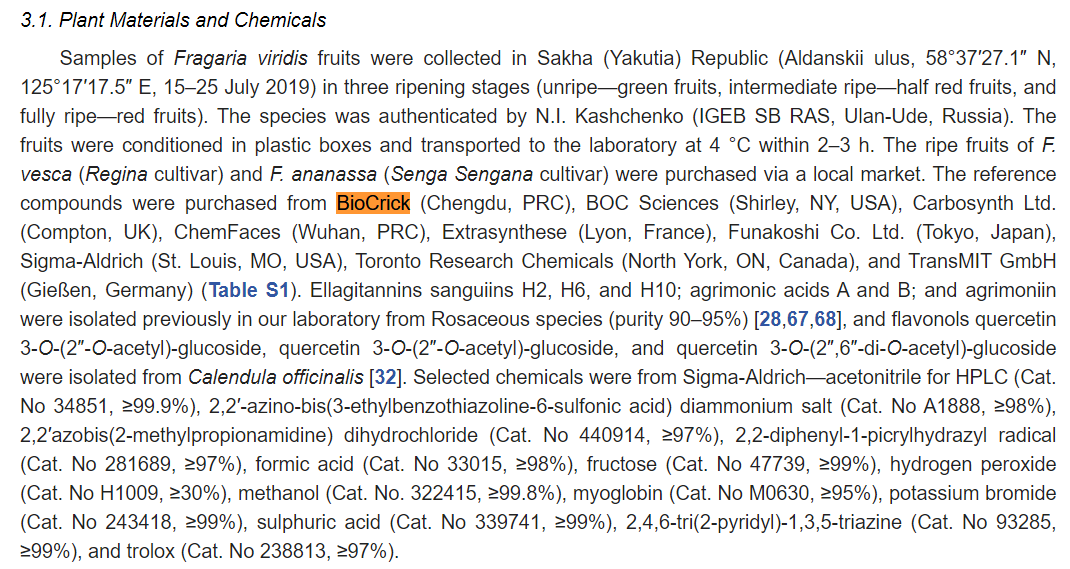Fragaria viridis Fruit Metabolites: Variation of LC-MS Profile and Antioxidant Potential during Ripening and Storage
Pharmaceuticals (Basel). 2020 Sep 22;13(9):262
PMID:32971880
 Fragaria viridis Weston or creamy strawberry is one of the less-known species of the Fragaria genus (Rosaceae family) with a wide distribution in Eurasia and is still in the shadow of more popular relatives F. ananassa (garden strawberry) or F. vesca (wild strawberry). Importantly, there is a lack of scientific knowledge on F. viridis compounds, their stability in the postharvest period, and bioactivity. In this study, metabolites of F. viridis fruits in three ripening stages were characterized with high-performance liquid chromatography with photodiode array and electrospray ionization triple quadrupole mass spectrometric detection (HPLC-PAD-ESI-tQ-MS). In total, 95 compounds of various groups including carbohydrates, organic acids, phenolics, and triterpenes, were identified for the first time. The quantitative content of the compounds varied differently during the ripening progress; some of them increased (anthocyanins, organic acids, and carbohydrates), while others demonstrated a decrease (ellagitannins, flavonols, etc.). The most abundant secondary metabolites of F. viridis fruits were ellagitannins (5.97-7.54 mg/g of fresh weight), with agrimoniin (1.41-2.63 mg/g) and lambertianin C (1.20-1.86 mg/g) as major components. Antioxidant properties estimated by in vitro assays (2,2-diphenyl-1-picrylhydrazyl radical (DPPH), 2,2'-azino-bis(3-ethylbenzothiazoline-6-sulfonic acid) cation radical (ABTS), ferric reducing antioxidant power (FRAP), and oxygen radical absorbance capacity (ORAC)) showed good antioxidant potential in all ripening stages of F. viridis fruits. The pilot human experiment on the effect of F. viridis fruit consumption on the serum total antioxidant capacity confirmed the effectiveness of this kind of strawberry. Postharvest storage of ripe fruits at 4 °C and 20 °C lead to declining content in the majority of compounds particularly ascorbic acid, ellagitannins, and flavonols, with the most significant loss at room temperature storage. These results suggest that F. viridis fruits are a prospective source of numerous metabolites that have potential health benefits.
Fragaria viridis Weston or creamy strawberry is one of the less-known species of the Fragaria genus (Rosaceae family) with a wide distribution in Eurasia and is still in the shadow of more popular relatives F. ananassa (garden strawberry) or F. vesca (wild strawberry). Importantly, there is a lack of scientific knowledge on F. viridis compounds, their stability in the postharvest period, and bioactivity. In this study, metabolites of F. viridis fruits in three ripening stages were characterized with high-performance liquid chromatography with photodiode array and electrospray ionization triple quadrupole mass spectrometric detection (HPLC-PAD-ESI-tQ-MS). In total, 95 compounds of various groups including carbohydrates, organic acids, phenolics, and triterpenes, were identified for the first time. The quantitative content of the compounds varied differently during the ripening progress; some of them increased (anthocyanins, organic acids, and carbohydrates), while others demonstrated a decrease (ellagitannins, flavonols, etc.). The most abundant secondary metabolites of F. viridis fruits were ellagitannins (5.97-7.54 mg/g of fresh weight), with agrimoniin (1.41-2.63 mg/g) and lambertianin C (1.20-1.86 mg/g) as major components. Antioxidant properties estimated by in vitro assays (2,2-diphenyl-1-picrylhydrazyl radical (DPPH), 2,2'-azino-bis(3-ethylbenzothiazoline-6-sulfonic acid) cation radical (ABTS), ferric reducing antioxidant power (FRAP), and oxygen radical absorbance capacity (ORAC)) showed good antioxidant potential in all ripening stages of F. viridis fruits. The pilot human experiment on the effect of F. viridis fruit consumption on the serum total antioxidant capacity confirmed the effectiveness of this kind of strawberry. Postharvest storage of ripe fruits at 4 °C and 20 °C lead to declining content in the majority of compounds particularly ascorbic acid, ellagitannins, and flavonols, with the most significant loss at room temperature storage. These results suggest that F. viridis fruits are a prospective source of numerous metabolites that have potential health benefits.
- Ellagic acid
Catalog No.:BCN5533
CAS No.:476-66-4
- Neochlorogenic acid
Catalog No.:BCN4450
CAS No.:906-33-2
- Chlorogenic acid
Catalog No.:BCN5906
CAS No.:327-97-9


